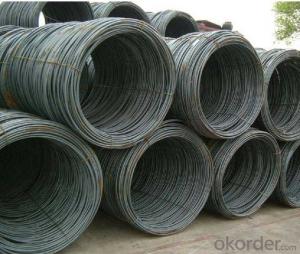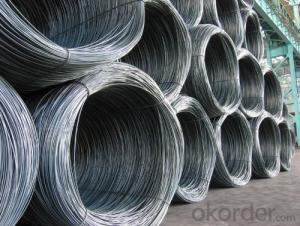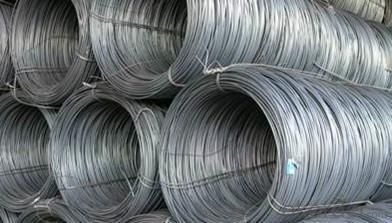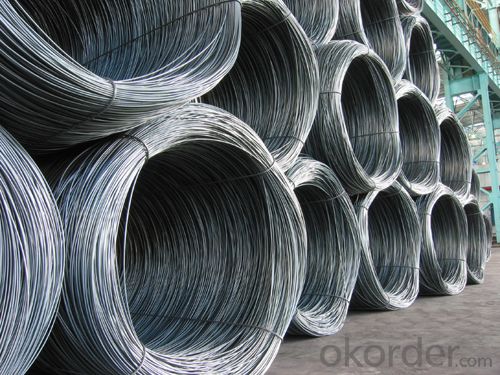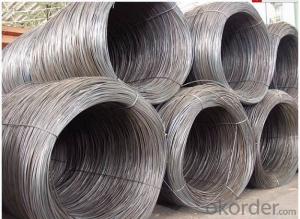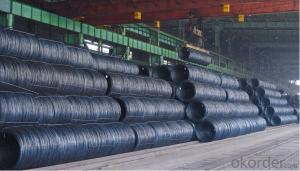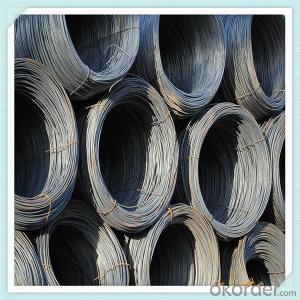Hot Rolled Carbon Steel Wire Rod 6.5mm with High Quality
- Loading Port:
- China Main Port
- Payment Terms:
- TT or LC
- Min Order Qty:
- 20 m.t.
- Supply Capability:
- 20000 m.t./month
OKorder Service Pledge
OKorder Financial Service
You Might Also Like
Product Description:
OKorder is offering Hot Rolled Carbon Steel Wire Rod 6.5mm with High Quality at great prices with worldwide shipping. Our supplier is a world-class manufacturer of steel, with our products utilized the world over. OKorder annually supplies products to European, North American and Asian markets. We provide quotations within 24 hours of receiving an inquiry and guarantee competitive prices.
Product Applications:
Hot Rolled Carbon Steel Wire Rod 6.5mm with High Quality is widely used in construction and manufacturing. Carbon steel wire rod is mainly used for reinforcement of reinforced concrete and welded structure or reprocessed (roberts , nail, etc.) materials, especially used to produce wire drawing, welding electrode, nails, spring, electronic, precise machinery parts and so on.
Product Advantages:
OKorder's Hot Rolled Carbon Steel Wire Rod 6.5mm with High Quality are durable, strong.packed and suitable for wire mesh,nail manufacture and construction
Main Product Features:
· Premium quality
· Prompt delivery & seaworthy packing (30 days after receiving deposit)
· Can be recycled and reused
· Mill test certification
· Professional Service
· Competitive pricing
Product Specifications:
Manufacture: Hot rolled
Grade: SAE1006 SAE1008 SAE1010 SAE1012 SAE1016 SAE1018
Certificates: ISO, SGS, BV, CIQ
Weight per Coil:2-2.05tons
Packaging: Export packing, packed by coil
FAQ:
Q1: Why buy Materials & Equipment from OKorder.com?
A1: All products offered byOKorder.com are carefully selected from China's most reliable manufacturing enterprises. Through its ISO certifications, OKorder.com adheres to the highest standards and a commitment to supply chain safety and customer satisfaction.
Q2: How do we guarantee the quality of our products?
A2: We have established an advanced quality management system which conducts strict quality tests at every step, from raw materials to the final product. At the same time, we provide extensive follow-up service assurances as required.
Q3: How soon can we receive the product after purchase?
A3: Within three days of placing an order, we will begin production. The specific shipping date is dependent upon international and government factors, but is typically 7 to 10 workdays.
Q4: How many tons can be loaded into one 20ft container?
A4: Around 18—20tons
Q5: What is the chemical composition and physical properties of SAE1008?
A5:
Grade | Chemical Composition (%) | |||||
C | Mn | S | P | Si | B | |
SAE1008B | 0.10max | 0.32max | 0.045max | 0.040max | 0.30max | 0.0008min |
Mechanical properties | ||||||
Yield strength(N/mm2) | Tensile strength(N/mm2) | Elongation (%) | ||||
≥195 | 350-380 | ≥32 | ||||
Images:

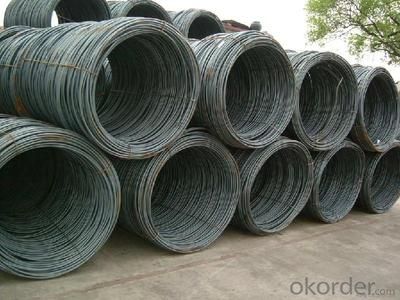
- Q: How is steel wire rod processed for subsequent applications?
- Steel wire rod is processed for subsequent applications through a series of steps that involve cleaning, heating, rolling, and cooling. The wire rod is first cleaned to remove any impurities and then heated to the desired temperature for easy shaping. It is then passed through a series of rolling mills to reduce its diameter and increase its length. Finally, the wire rod is cooled and coiled into spools or cut into desired lengths, ready for various applications such as construction, automotive, or manufacturing industries.
- Q: What are the standard surface roughness requirements for steel wire rod?
- The standard surface roughness requirements for steel wire rod vary depending on the specific application and industry standards. However, in general, steel wire rod is expected to have a smooth and uniform surface with minimal imperfections. For construction purposes, such as reinforcing concrete structures, the surface roughness requirements are relatively lenient. It is common for steel wire rod used in construction to have a surface roughness of Ra 3.2 to 6.3 micrometers (125 to 250 microinches). In contrast, for more demanding applications like precision engineering or automotive manufacturing, higher surface quality is required. In these cases, the surface roughness requirements for steel wire rod are typically stricter, with a range of Ra 0.8 to 1.6 micrometers (32 to 63 microinches). It is important to note that these values are not universal and can vary depending on specific industry standards or customer preferences. Manufacturers and suppliers of steel wire rod typically provide detailed specifications and standards that need to be met for specific applications, ensuring that the required surface roughness is achieved.
- Q: What are the main competitors of steel wire rod?
- The main competitors of steel wire rod include aluminum wire rod, copper wire rod, and synthetic fiber materials like nylon and polyester that are used as alternatives in various industries.
- Q: How is steel wire rod used in the manufacturing of wire forms for aerospace applications?
- Steel wire rod is used in the manufacturing of wire forms for aerospace applications as it provides high strength and durability, making it suitable for critical components. The wire rod is first drawn through a series of dies to obtain the desired diameter and then undergoes various shaping processes such as bending, coiling, or twisting to create intricate wire forms. These wire forms are used in various aerospace applications such as aircraft seating, control systems, and structural components due to their ability to withstand high loads and maintain their shape even under extreme conditions.
- Q: How is the demand for steel wire rod expected to change in the future?
- The demand for steel wire rod is expected to increase in the future due to its diverse applications in various industries such as construction, automotive, and manufacturing. As these industries continue to grow and develop, the need for steel wire rod for products such as cables, wires, and reinforcement materials will also rise. Additionally, advancements in technology and infrastructure projects worldwide will further contribute to the increasing demand for steel wire rod.
- Q: What are the safety considerations for using steel wire rod in construction?
- Some safety considerations for using steel wire rod in construction include ensuring proper handling and storage to prevent injuries, using appropriate personal protective equipment such as gloves and safety glasses, conducting regular inspections to check for any defects or damage in the wire rod, and following proper installation techniques to ensure structural integrity and prevent accidents.
- Q: How does the elongation of steel wire rod vary with different heat treatment processes?
- The elongation of steel wire rod is influenced by different heat treatment processes. Heat treatment involves subjecting the steel wire rod to specific temperatures and cooling rates to alter its structure and properties. One common heat treatment process for steel wire rod is annealing. During annealing, the wire rod is heated to a high temperature and then slowly cooled. This process relieves internal stresses and allows for the formation of a more uniform and ductile microstructure. As a result, the elongation of the steel wire rod typically increases after annealing. The increased elongation is due to the reduction in brittleness and the improved ability of the material to deform without fracturing. On the other hand, another heat treatment process called quenching and tempering involves rapid cooling followed by reheating and slow cooling again. Quenching hardens the steel wire rod, making it stronger and more resistant to deformation. However, this process can also make the material more brittle, reducing its elongation. The subsequent tempering process relieves some of the brittleness while maintaining the strength, resulting in a moderate elongation. In summary, the elongation of steel wire rod varies with different heat treatment processes. Annealing increases elongation by improving ductility and reducing brittleness, while quenching and tempering can result in a moderate elongation by balancing strength and brittleness. The specific heat treatment process chosen for steel wire rod depends on the desired mechanical properties and performance requirements for its intended application.
- Q: What are the common joining methods for steel wire rod?
- The common joining methods for steel wire rod include welding, brazing, and mechanical joining techniques such as crimping or swaging.
- Q: How is steel wire rod used in the manufacturing of wire rope clips?
- Steel wire rod is used in the manufacturing of wire rope clips as it serves as the primary material for creating the clips themselves. The steel wire rod is first processed and shaped into the desired clip design, providing the necessary strength and durability required for securing wire ropes.
- Q: How is steel wire rod classified based on its strength?
- Steel wire rod is classified based on its strength through a grading system known as the grade or grade number. The grade number indicates the tensile strength of the steel wire rod, which is the maximum amount of stress the wire rod can withstand before breaking. The higher the grade number, the stronger the wire rod is. The classification of steel wire rod based on its strength typically ranges from grade 1000 to grade 4000. Grade 1000 wire rod has the lowest tensile strength, usually around 1000 megapascals (MPa), while grade 4000 wire rod has the highest tensile strength, typically around 4000 MPa. Each grade of wire rod is designed for specific applications and industries. Lower grade wire rods are suitable for less demanding applications such as general construction, fencing, and mesh manufacturing. They are often used where high strength is not a primary requirement. On the other hand, higher grade wire rods are used in industries where exceptional strength is crucial, such as automotive, aerospace, and manufacturing of high-tensile steel cables. These wire rods are engineered to withstand extreme forces and are typically used in critical applications that require superior strength and performance. In addition to the tensile strength, steel wire rod can also be classified based on other properties such as ductility, corrosion resistance, and formability. These properties play a significant role in determining the suitability of the wire rod for specific applications. Overall, the classification of steel wire rod based on its strength is essential in selecting the right material for various applications. It allows engineers and manufacturers to choose wire rods that can withstand the required forces and perform optimally in their respective industries.
Send your message to us
Hot Rolled Carbon Steel Wire Rod 6.5mm with High Quality
- Loading Port:
- China Main Port
- Payment Terms:
- TT or LC
- Min Order Qty:
- 20 m.t.
- Supply Capability:
- 20000 m.t./month
OKorder Service Pledge
OKorder Financial Service
Similar products
Hot products
Hot Searches
Related keywords

